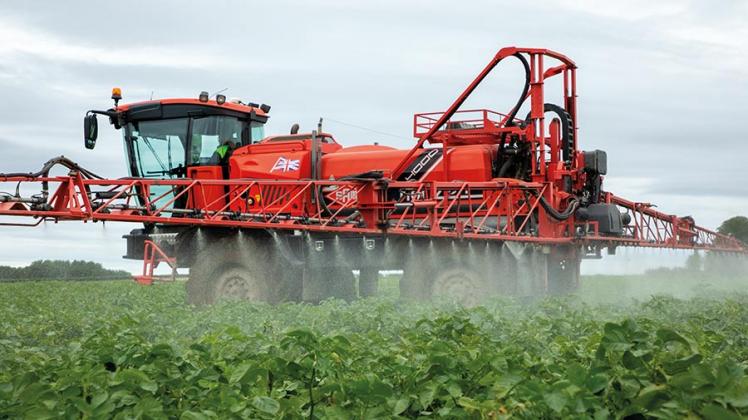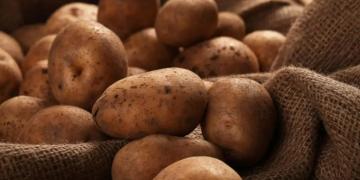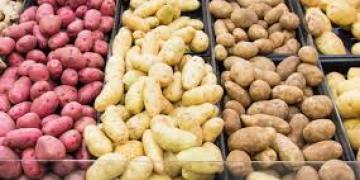Gran Bretaña: Weather expected to bring potato crops and maleic hydrazide timings forward
An early season and the threat of secondary growth means potato growers should check crops now for tuber sizing and be prepared to apply maleic hydrazide two weeks earlier than normal.

Largely dry and bright weather this year has provided excellent growing conditions for potato crops across the country but is bringing with it some agronomic challenges.
Norfolk-based adviser Tim Kitson says irrigators have been working flat out to keep up with crop water demand and some unirrigated crops in East Anglia are already showing signs of stress.
See also: Why potato sprout management now starts in the field
With high temperatures forecast into the second half of July, this leads to a concern that when a deluge of rain does occur, secondary growth and chain tuberisation will be triggered that severely dent tuber quality.
Maleic hydrazide helps mitigate the issue and Mr Kitson says this adds to an already compelling case to use it in potato crops destined for store.
“With potato markets tight, the last thing you need is loss of quality, and a well-timed application of maleic hydrazide can help protect marketable yield. It is also the best start to storage programmes and many more growers are using it now,” he adds.
Two weeks earlier
“We are about two weeks ahead of usual in terms of development, so we are checking crops for size and condition and getting it on as soon as conditions allow,” he says.
Fellow potato specialist Andy Alexander oversees largely processing crops across East Anglia and says that since chlorpropham (CIPC) was banned, sprout control costs have increased across the board.
With no like-for-like replacement, he says the importance of using foliar applied maleic hydrazide (MH) has increased significantly, as it can give a long period of sprout control in the early stage of medium- and long-term storage.
Storage savings
This can negate or delay the need for in-store fog treatments such as mint and orange oils and ethylene gas well into the spring.
“I’ve found that MH gives good control right through to February or March. I’ve been using a lot of ethylene where the end user allows, and it has helped delay applications until the spring.
“In other crops where ethylene isn’t acceptable, growers have saved two or three applications of mint or orange oil in some cases,” says Mr Alexander.
He has been using MH – contained in products Crown MH and Fazor – for volunteer control for many years, with the product preventing lost tubers from growing in following crops.
Explore moreKnow How
Visit our Know How centre for practical farming advice
Potatoes crop management
Potatoes harvest and crop storage
These plants can then become sources of diseases such as late blight and potyvirus for nearby potato crops and propagate soil-borne pests and pathogens such as potato cyst nematode (PCN) and rhizoctonia.
In the past and when only targeting volunteers, optimum application parameters were not considered perhaps as much as they should have been, but now MH is the foundation for sprout control, this must change to maximise its cost-saving potential in store.
Optimum timing
Mr Alexander says this means applying it to an unstressed crop that is actively growing, ahead of when it begins to senesce naturally and when tubers are the appropriate size.
Manufacturers recommend applying three to five weeks before the start of haulm destruction and he favours going as soon as environmental conditions are correct.
It is particularly important to look at temperatures and avoid application in the heat of the day.
“One thing I will always advise growers to do is apply in the evening or through the night, with at least 24 hours of dry weather with no irrigation behind it. I also advise a big water rate of 450 litres/ha,” explains Mr Alexander.
Unirrigated crops
Mr Kitson says unirrigated crops may pose the biggest challenge for getting application timing correct, as they will be under the most stress if dry conditions remain.
He says that users will be aware that applying MH too early can hit yield, but the threat of secondary growth this season means it may be a risk worth taking.
“I’ve seen missed areas where growers have been trialling early MH applications in recent seasons. The treated areas may have yielded less, but there was less secondary growth and fewer problems in store.
“It’s also important to keep MH-treated and non-treated crops and different fields separate, as it will make it easier to monitor dormancy throughout the storage period,” he adds.
Mr Kitson says his growers use a mixture of Fazor and Crown MH, with no difference in efficacy providing both products are applied at the right time.
Closed transfer system
However, from an operational efficiency point of view, using a closed transfer system with 600-litre intermediate bulk containers (IBCs) makes life easier for sprayer operators covering a larger potato area.
Certis Belchim technical specialist Harry Raley says the product is transferred from IBCs into the sprayer using a Wisdom Systems Fastran 850 closed transfer system, which is plumbed into the sprayer’s venturi system.
“It transfers the liquid at about 25 litres/min.”
Mr Raley notes that over the past two seasons operators using the IBC system have sprayed an extra load or two in shifts when conditions were just right for MH application, increasing the chances of maximum uptake.
Maleic hydrazide in 2022 – key points
Threat of secondary growth/chain tuberisation strengthens case for MH
Save on already high storage costs by delaying need for in-store treatment
Applications could need to be two weeks ahead of usual – check crops now
Apply in optimum conditions:
Three to five weeks before desiccation
When 80% of tubers are >25mm
Temperature <25C
Relative humidity >75% and unlikely to fall
No rain forecast or irrigation scheduled for at least 24 hours
Water rates of 400 litres/ha plus
Liquid formulation helps with operational efficiency
Fuente: https://www.fwi.co.uk/arable/crop-storage/weather-expected-to-bring-potato-crops-and-maleic-hydrazide-timings-forward




